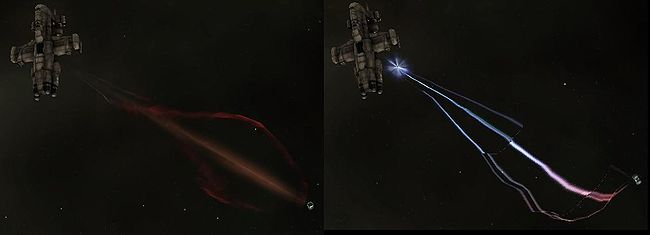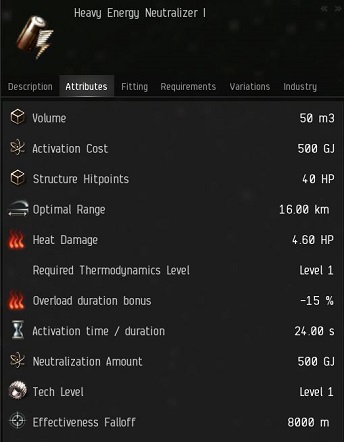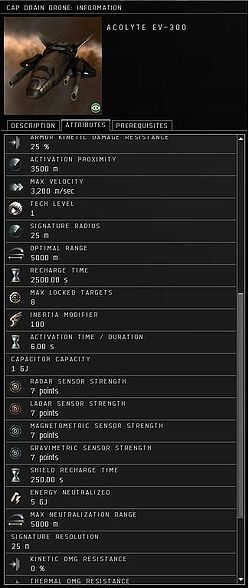Capacitor warfare

or Why These Pictures are Some of the Prettiest Things You Will See in EVE.
This is an ongoing project. Any changes or help will be appreciated and then mutilated, hacked, revised and generally forced into the authors grand vision (ha ha ha). Once an intial draft is completed (yes this will take months) a thread on the forums will be established for discussion and corrections. Thanks!
Capacitor Warfare Overview
You have probably heard someone say 'Cap is life' during your time in EVE. There are many good reasons why this is true, and every one of them is also a good reason why Capacitor Warfare is one of the most direct ways to go for the throat of an enemy. Capacitor directly feeds laser and hybrid turrets, keeps active tanks running, and powers the majority of fighting midslot modules including all EWAR modules and all propulsion systems. An enemy without capacitor is an enemny without options which means you instantly get to dictate the flow of the battle - kill them your way or if something goes wrong you can always rest confidently knowing that warp jamming requires cap.
Cap Warfare is the strange cousin of EWAR that no one talks about. Rarely will you see EWAR guides include Cap Warfare even though that is where it rightfully belongs, much like tackling. Capacitor Warfare has had its ups and downs in the history of EVE, with its wild days of overpowered glory, and subsequent 'rebalancing' lows. It is still and will always be an extremely viable tactic in the sandbox of EVE, and the pendulum will continue to swing back and forth over the impossible 'balanced' ideal, but knowing what and how is extremely important even if you never plan to employ cap warfare.
Capacitor Warfare, as in direct action taken to reduce or elminate the capacitor of a target, can be accomplished a few ways:
- Using one of two types of Engineering Equipment modules
- Energy Destabilizers - small, medium and heavy energy neutralizers of various meta levels
- Energy Vampires - small, medium and heavy nosferatu of various meta levels
- Using one of three Combat Utility Drones
- Light, medium and heavy energy neutralizer drones based on Amarr drone models - the Acolyte EV-300, Infiltrator EV-600, and Praetor EV-900
(as an aside if you have ever been curious where the word nosferatu comes from check out this link to Nosferatu)
Each of the these systems has its own strengths and weakneses and are very different in implementation although all are focussed on the same goal.
- Energy Destabilizers - ie the assortment of Neutralizers (Neuts)
- Strengths
- Neutralizes large portions of the enemies capacitor every cycle
- Weaknesses
- Requires large amounts of your capacitor
- Long cycle time
- Short ranges though increasing with module size
- Strengths
- Energy Vampires - ie the assortment of Nosferatus (Nos)
- Strengths
- Amount of cap removed from the target is transferred to you
- Quick cycle time
- Weaknesses
- Only transfers cap when your PERCENTAGE of capacitor is below the percentage of the targets capacitor
- Transfers small portions of capacitor
- Short ranges though increasing with module size
- Strengths
- Energy Neutralizer Drones
- Strengths
- normal Drone range mechanics
- Neutralizer drones have no impact on your cap
- Weaknesses
- normal Drone weaknesses of vulnerability, flight times etc.
- Constant cycle time of 6 seconds for each type of drone with only small portions of cap neutralized
- Strengths
So these are the tools at your disposal if you decide to bring the pain directly to your opponents capacitor. Keep reading for how they work, what ships they work best on and how to make them work for you.
How Destabilizers, Vampires, and Neutralizer Drones Work
Energy Destabilizers
Energy Neutralizers are the heavy hitters of cap warfare. They can remove huge amounts of cap and leave an enemy 'capped out' faster than any other form of cap warfare.
Here is screenshot of the attributes of the meta 0 heavy neut:
Generally all neutralizers will have a similar set of attributes. The different sizes of neutralizer differ significantly, but they all fairly consistent across meta levels. Besides fitting considerations, the only attributes that change from meta 0 all the way to commander modules is the range and the amount of energy neutralized. The cycle time is consistent (6 seconds for small neuts, 12 seconds for medium, and 24 seconds for heavy) as well as the energy 'cost' to neutralize (45 GJ for small, 150 GJ for medium, and 500 GJ for heavy). Therefore, at each size higher meta modules are more efficient: meta 0 modules destabilize as much as their activation cost (100% efficiency), and it trends up to meta 5 (tech II) and higher modules at 120% efficiency. Using the heavy neut example a Tech II neut would neutralize 600GJ with its 500GJ activation cost. The range for modules from meta 0 to the highest are: small from 5,250m - 7,350m; medium from 10,500m - 14,000m; and heavy from 21,000m - 39,200m.
So with these capabilities in mind, if you are within range of a target and activate an energy neutralizer the activation cost will immediately be deducted from your capacitor and the neutralization amount will be deducted from the targets capacitor (test and verify). Each cycle time if still within range this will be repeated for as long as you have capacitor to run it. Pretty simple, right?
The important thing to remember is that your goal is to 'cap out' your opponent and that their capacitor will continuously be recharging. So if you are not using a large enough neutralizer to overcome the peak recharge rate of their capacitor you are more or less wasting your time. Yes, you will make it harder for them to run cap stable, but likely you would be a more efficient killing machine using that high slot for something else if that is all you are accomplishing.
So you want: Neutralization Rate > opponent recharge rate in GJ/S
And Neutralization Rate is defined as: ((Energy Neutralized in GJ)/(Activation Time in seconds))
The delta is the rate at which you will cap out your target. Remember however, that the recharge rate varies with the percentage of remaining cap so that in fact your neutralizing effectiveness will be highest when the opponents capacitor is closest to 0% and 100%. (I will leave the math and actual formula out of this guide) This means that it is easier to keep someone cap drained than it is to drain them in the first place. This is an important factor in the fighting and fitting section of this guide. But the basic rule of thumb is that a good Cap Warfare setup has a neutralization rate MUCH higher than any concievable recharge rate. You want to cap out your opponent quickly and then have an easy way to keep the other pilot running on empty.
Energy Vampires
The vampires of cap warfare are Nosferatus. They remove small amounts of cap, but instead of costing your own cap to do this they will actually give you the cap your opponent lost. Because of the huge potential of being able to hurt a target while helping yourself there are several rather severe limitations on these modules.
Here is screenshot of the attributes of the meta 0 heavy nos:
Generally all nosferatus have a similar set of attributes. The first drawback of nos is that they are harder to fit than neuts of equivalent size requiring more CPU. The only attributes that change from meta 0 all the way to commander modules is the range and the amount of energy transferred to you. The cycle time is consistent (3 seconds for small nos, 6 seconds for medium, and 12 seconds for heavy). Small nos will transfer from 8 - 10 GJ across the meta levels, medium from 30 - 36 GJ, and heavy from 100 - 135 GJ. The ranges for all the modules from meta 0 to the highest are between: small from 5,500m - 10,214m; medium from 10,500m - 19,500m; and heavy from 21,000m - 43,000m.
So if you are within range of a target and activate an nos the exact same thing will happen as with a neut except now the 'activation cost' is a negative amount equivalent to the amount removed from the opponent credited to your capacitor.
The low amounts of energy actually removed from a target while using a nosferatu makes it practically impossible to cap out an opponent using these modules. To compare it directly to an equivalent neut multiply the amount of energy transfered by 2 since the cycle time is always half that of a neutralizer and you will see just how much less energy is removed. As well Nosferatus have the additional limitation of only transferring energy when the opponents capacitor has a higher percentage of charge then your own. Essentially in order to cap out it requires you to be capped out as well. These are pretty severe limitations. However, nosferatus are still extremely useful modules in certain circumstances and using them effectively will be discuss more in the fitting and fighting section.
Energy Neutralizing Drones
Light, medium and heavy neutralizing drones have the same general characteristics as other drones. General infomation can be found here and will not be discussed in this guide.
Here is a screenshot of the attributes with the information on neutralization for each of the drones:
As you can see cycle times are identical for all 3 sizes of drones at 6 seconds. The amount neutralized is easy to remember as well as it is identical to the drone bandwidth: 5 GJ for light, 10 GJ for medium, and 25 GJ for Heavy drones. Like all other drone based EWAR, pilot ewar skills have no effect on the drones and there is no stacking or usage concerns between drones.
Accordingly a full flight (5) of light drones will neutralize 25 GJ every 6 seconds. This is roughly 1/2 as effective as 1 small neut.
A full flight (5) medium drones will neutralize 50 GJ every 6 seconds. This is roughly 2/3 as effective as 1 medium neut.
A full flight (5) heavy drones will neutralize 125 GJ every 6 seconds. This is exactly as effective as 1 meta 0 heavy neut.
So knowing this approximate effectiveness together with the strengths, such as great range, and weaknesses, such as targetability, of drones we will discuss their use in the fitting and fighting section.
Skills
The only skill that directly impacts the effectiveness of your Capacitor Warfare modules, and then only neutralizers, is Energy Emission Systems. This skill will reduce the activation cost of all neuts by 5% per level with excellent results on efficiency. At level 5 a Tech II heavy neut will only require 375 GJ per cycle to neutralize 600 GJ. This is 160% efficiency. Unfortunately this has no positive effect on nos or drones as they do not require any capacitor to activate.
As is readily apparent, the better your capacitor is the better you can conduct effective cap warfare. Therefore both Energy Management and Energy Systems Operation are extremely important skills together with all the supporting capacitor management skills as listed in Capacitor Management 101.
Capacitor Warfare and PvE
The NPCs you fight in EVE 'cheat'. One of the ways they do this is by having infinite capacitors. It is impossible to 'cap out' a rat as there is no way to reach the bottom of their cap.
Under the player to NPC behaviour for EWAR, is the caveat that use of neutralizers (including drones) or nos on NPCs will result in a chance of disrupting both shield or armour repairing by the NPC. I don't know the numbers but the chance of disrupting repairs increases with the size of the modules and decreases with the size of the NPC ship. So using a heavy neut on a frigate NPC should have a very high chance of stopping any repairs. Likewise using a small nos on a BS NPC will have little to no effect on stopping repairs.
Additionally because they have infinite cap a nos can be counted on to provide infinite power to the user. As soon as you are below 100% capacitor you can always steadily draw cap from an NPC with a nos. Yes, this can be used in mission running quite effectively with certain setups, range likely being the prime limitation. Yes, this means that if you are ever in the situation of sitting on a low sec gate tanking gate guns (not in the Uni of course) you can sit beside the billboard and pull as much cap from it as your nos will handle to keep your repairers running smoothly.
Ships
Any empty utility high slot or spare drone capacity is a reason to consider using capacitor warfare on any ship. However, certain ships excel at using this form of EWAR.
Things you need for cap warfare? A strong capacitor yourself if neuts are planned. However, nos will actually help bolster a weak capacitor and drones will have no effect either way. A setup already dependent on close range lends itself to use of neuts or nos, or a long range ship looking for options against close range aggressors. Spare high slots or drone capacity are of course essential.
Prime examples of 'casual' capacitor warfare usage would be a blaster boat with a Nos in a utility high, or an EWAR boat like an Arbitrator with 'defensive' neuts in case a fast tackler gets too close. Many solo fits for frigates with a utility high include a nos to keep the frigate's tackle, guns and tank running if it attacks a larger ship which has a neut fitted. Solo/small gang fits for several Minmatar ships (commonly the Rupture, Hurricane, Typhoon and Tempest) often include at least one medium or large neut in their utility highs as part of their defence against smaller targets, especially since the disadvantage of generally small capacitors is rendered irrelevant by using neuts against ships a class size smaller.
T1 Usage
There are no T1 hulls in the game with a direct bonus to capacitor warfare, but some ships are better suited for it than others.
Since the strength of capacitor is the number 1 consideration on a non-bonused hull, Amarr ships are generally the best non bonused cap warfare ships. The general race capacitor strengths are Amarr > Gallente ~ Caldari > Minmatar. Minmatar ships and Gallente droneboats are often particularly well supplied with utility highs. Any ship which doesn't use capacitor to run its weapons (Minmatar projectile ships, Gallente drone ships, Caldari missile ships and Amarr ships fitted with projectile turrets) or to maintain its tank (buffer armour tanks and passive shield tanks without active hardeners) has more capacitor to spare for capacitor warfare.
Punisher
The Punisher has an inordinately large capacitor for a T1 frigate. In fact, at 425 GJ without skills, it is larger than its runners up by 75 GJ (the Caldari Merlin and Gallente Tristan at 350 GJ - the Minmatar Rifter only has a 250 GJ capacitor), it is also has a larger one than all T2 frigates other than the Retribution (Amarr Assault Ship), and most of the faction frigates. It also has a utility high slot unuseable for DPS due to the number of turrent and lack of missile slots. Finally it is particularly well suited to a negligable (DCU) capacitor armour tank due to its inherrent armour resist bonuses, four low slots, and very nice amount of shield and armour HP. Taken together the Punisher is the undisputed King of T1 frigate cap warfare platforms.
- The Punisher is the T1 frigate with the most robust capacitor and at least one (venerable) strategy for fitting it relies on a nos in precisely this way.
cruisers tbi
bcs tbi=
Dominix=
- Gallente drone boats rely on drones for much of their DPS and sometimes fit their high slots for capacitor warfare -- neuts are particularly common on the Dominix.
- The Amarr Arbitrator is also a drone boat, and so sometimes fits neuts and/or noses for the same reason.
Ships with Capacitor Warfare Bonuses
Amarr Ships
Sentinel
Pilgrim
Curse
Blood Raider Ships
Cruor
Ashimmu
Bhaalgorn
Fitting and Fighting for Cap Warfare
Credits

